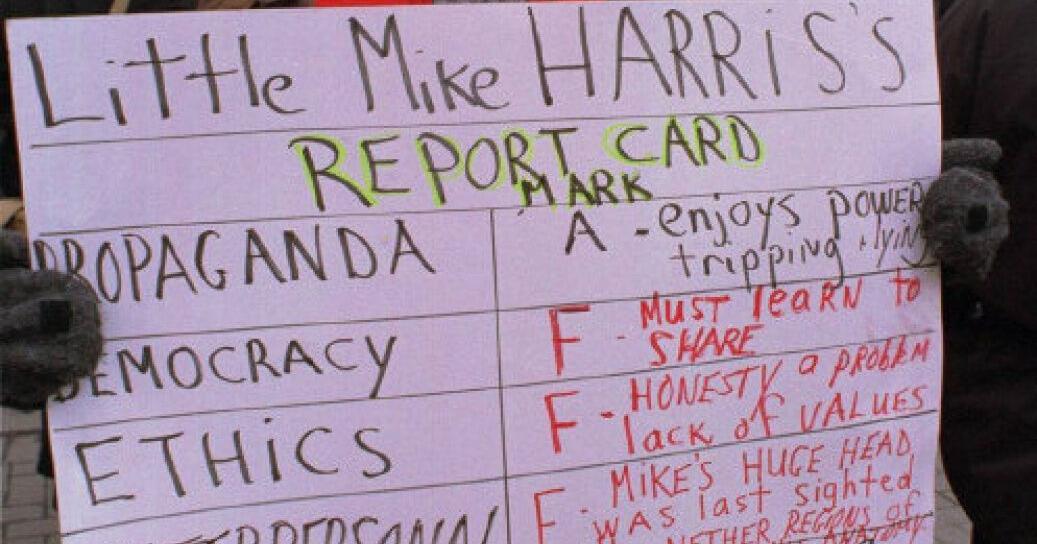Here you go - this seems to be written in 2015:
Teacher strikes: Ontario strikes and lockouts since 1987
There’s hasn’t been a full-blown strike or lockout involving Ontario’s secondary school teachers since 1997.
The current strikes in Durham, Sudbury and Peel mark the Ontario Secondary School Teachers’ Federation’s first all-out job actions in 18 years.
There have been targeted job actions, such as work to rule campaigns that eliminated extracurriculars, but no full-fledged, full-scale walkouts.
Here’s a list of Ontario school job actions going back to that mother of all teachers’ strikes:
Halloween 2013: Elementary and junior high school teachers across Ontario
The teachers staged a one-day walkout in response to collective agreements imposed by the McGuinty government.
Dec. 18, 2012: Toronto, Peel and Durham public elementary boards
They walked off the job and shut down schools, joined by teachers at five other boards across Ontario: Greater Essex in the Windsor area, Lambton-Kent in Sarnia and Chatham, Waterloo, Grand Erie in Brantford and Near North in North Bay.
This was the climax of a series of rotating one-day strikes over the previous weeks protesting Bill 115, which allowed the province to impose labour contracts on teachers and limited their ability to strike. (It was later repealed.)
May 16, 2003: Toronto Catholic District School Board
The board locked out its elementary school teachers, who had been without a contract since August and had been working to rule since February.
The board maintained it could not afford to pay teachers a raise of more than 6.5 per cent over two years.
The union sought at least 7.5 per cent.
The lockout lasted 12 days and schools reopened after the Ontario government passed back-to-work legislation on June 2, 2003.
Nov. 4, 2002: Simcoe Muskoka secondary students
A teachers’ strike shut down Catholic high schools across cottage country, affecting more than 7,000 students.
After a week of rotating one-day walkouts, teachers launched its full-scale strike over wages and working conditions.
That strike ended after three weeks with back-to-work legislation.
Nov. 30, 2002: Simcoe-Muskoka Catholic District School Board
More than 15,000 elementary school students with the Simcoe-Muskoka Catholic District School Board were off the job for two weeks.
The strike ended when their union, which represented 800 elementary school teachers at 41 schools, agreed to voluntary arbitration.
Nov. 29, 1998: York Region elementary teachers
There were two months of strife across the region’s 108 public elementary schools.
Rotating strikes shut about 20 schools for a day.
The 3,214 elementary teachers worked to rule. The board responded by locking them out for five days. The teachers answered back with the rotating strikes.
Sept. 29, 1998: Teachers across province
School started late for some 210,000 students from eight school boards across Ontario, after the three parties in the Ontario Legislature brokered a deal to get a back-to-work bill introduced and passed into law.
There had been a collection of teachers’ strikes and school board lockouts, costing 133,000 students in the GTA 15 days of classes.
Oct. 27, 1997: Teachers across province
A province-wide, two-week strike was staged in protest of Bill 160, which increased the time teachers were expected to spend in front of students.
Principals and vice-principals joined the strikers, which outraged the government. It affected 2.1 million elementary and secondary students.
The legislation was passed, despite the mass job action.
Oct. 18, 1987: Metro elementary school teachers
Metro Toronto’s first strike by public elementary school teachers affected 157,000 students and lasted 26 days.
A key issue was preparation time.
The union wanted 200 minutes a week. The board eventually settled for 100 minutes in the first year of the contract and 120 minutes in the second year.



















